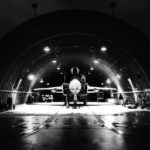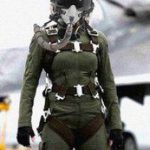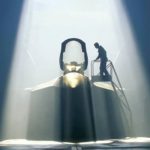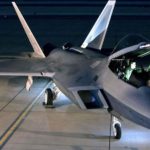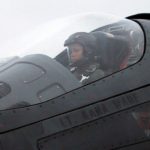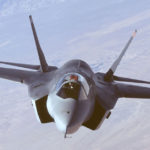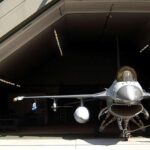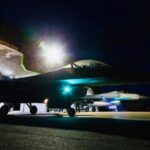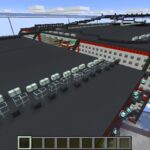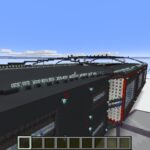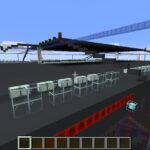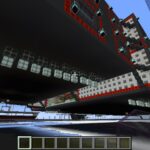These are where most, if not all, of this carrier’s fighter-craft are stored, always 1 in each of these smallest of its hangars –thus these hangars are more-often referred to as garages.
–
Table of Contents:
- Introduction
- Number & Locations
- Dimensions
- Personnel
- Contents
- Access
- Conceptual Images
- 2022 Scale-model in Minecraft
–
Introduction:
These are the only hangars in this carrier which are designed for only one craft, and only one type of craft; they are specifically built to receive and launch the type of human-made Space-worthy fighter-jets that the UAP uses in this time period; the early 2500s, A.D..
While it is possible for them to receive and assist any craft of similar/identical dimensions, their role is to provide guaranteed immediate docking and refitting/servicing for the fighter-pilots/craft of this carrier/fleet.
These prevent evasive maneuvers and gravity issues or docking/parking-clamps failures from letting expensive military craft slide around or bump into others, and they make it much less costly (energy-consuming) and less complicated to let craft in and out. They also make it nearly impossible to block fighters from taxiing, taking off, and landing; there is no single/main runway or hatch an enemy could damage.
Garages (this type of hangar in TNH) are specifically designed to automatically diagnose and repair, and to 3D-print replacement parts or entire fighters, if needed
(All other hangars in TNH have 3D-printing repair robotic-arms, but need a scan or digital blueprint of a non-Alliance/issue craft before they can perfectly repair its parts. They are also not designed for enclosed perfect replacement printing, only simpler repairs.)
–
Number & Locations:
Dozens of these single-craft hangars / fighter-garages line the top and bottom of the carrier. They are in four main rows; two on the top, and two on the bottom, each of those rows running from front to back of the carrier. Their hatches point out to the sides, such that every launch is not in the most-likely direction of travel, nor toward the main-thrusters at the back of the carrier.
These are in 12 groups of 13; 6 are on top of the carrier, and 6 on its underside.
5 squadrons of 21 = 105 pilots
13 garages x 12 lines = 156
Thus 51 of these garages can have recovery pods/drones for man-overboard or salvaging ops.
Backup fighters are not necessary, thanks to how quickly they can be repaired or replaced.
The extra 51 garages can also shelter and patch up the fighters of our escort ships if need be.
–
Dimensions:
Each of these hangars/garages is big enough to allow for the safe entry and exiting of 1 human-made fighter-craft, the standard/current make-and-model used by the UAP.
- ~50′ wide
- ~70′ deep (“long”) (60′ would work, but room is needed for the “tower” room’s bulge)
- ~20′ tall
–
Personnel:
There are usually only half a dozen people in any of these hangars, max;
- ~6 total
- ~1 in the ATC “tower” (room)
- Red (ordnance, EOD): ~1 or 2, only when loading new bombs/bullets/missiles
- Orange: N/A; each pilot handles the cleaning-out of his/her cockpit
- Yellow: sometimes (and at most) 1, though this person is usually in the “tower” (back-wall room)
- Green: only if there is a tractor-beam issue, and sometimes/usually the personnel in the “tower” of these hangars/garages double as this role
- Blue: 1, manning the lift which doubles as the floor of each of these hangars/garages, and only when a fighter-craft needs to be moved up into the hangar/garage, or when a fighter-craft already in the hangar/garage needs to be moved down out of it
- Purple: ~1 or 2, only when the fighter-craft in the given hangar/garage needs refueling
- Brown: 1, when called or scheduled for routine checks/approvals
- White: usually not necessary
- White-and-red-plus-sign: only if a returning pilot is injured
- Silver: only if there is a crash or fire
Sometimes there are just 2; 1 in the “tower”, and the pilot in the fighter-craft.
–
Contents:
There should only be 1 Spacecraft in each of these hangars/garages, and it should almost always be the fighter-jet assigned to it.
–
Access:
Only the pilot and whomever is assigned to help that pilot maintain and inspect his/her fighter-jet should be in these hangars/garages.
Access from TNH is via the lift which doubles as the floor.
Access from the outside is via the launch/recovery hatch which faces out to one side of TNH.
–
Conceptual Images:
–
2022 Scale-model in Minecraft:
–
